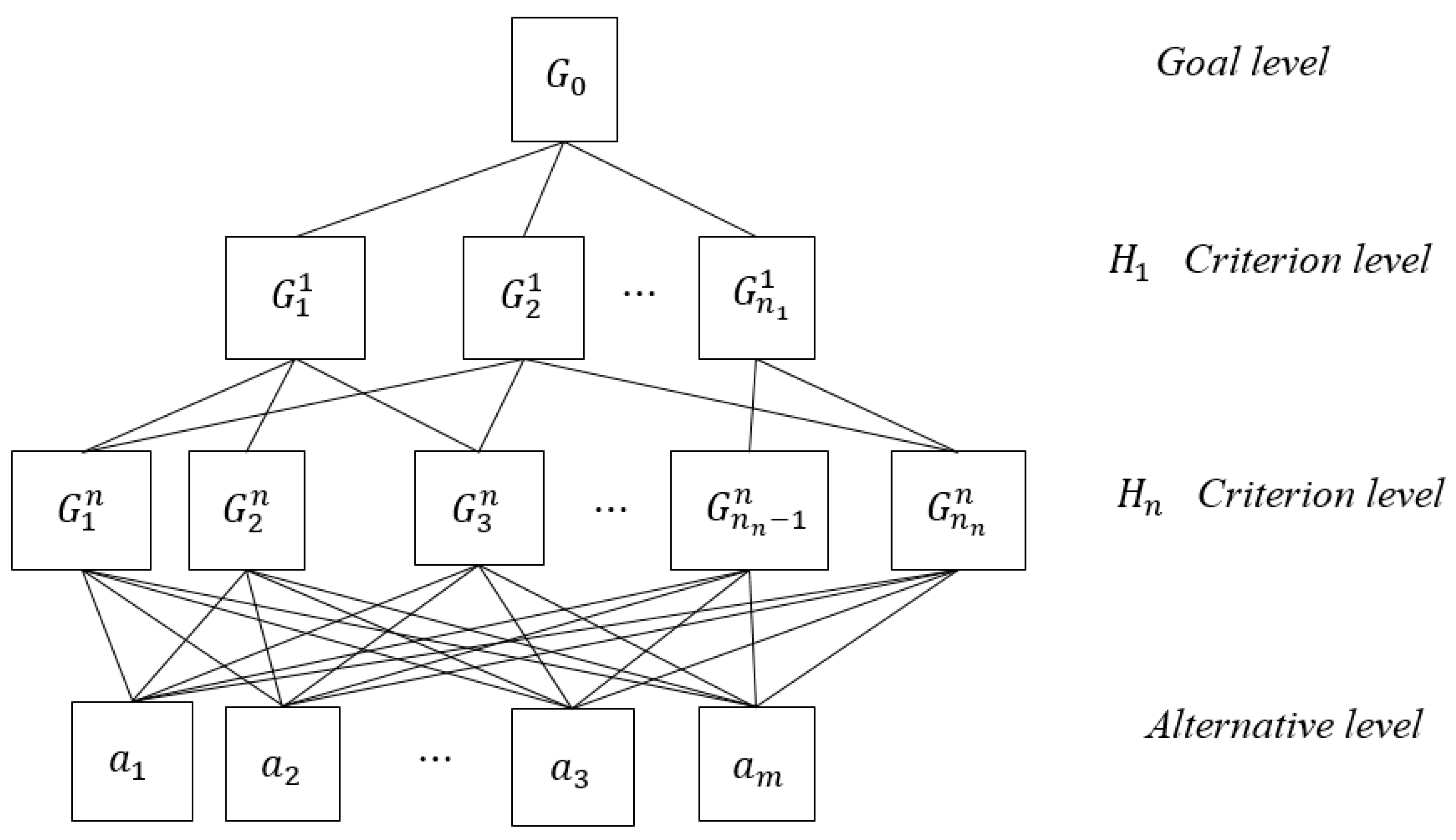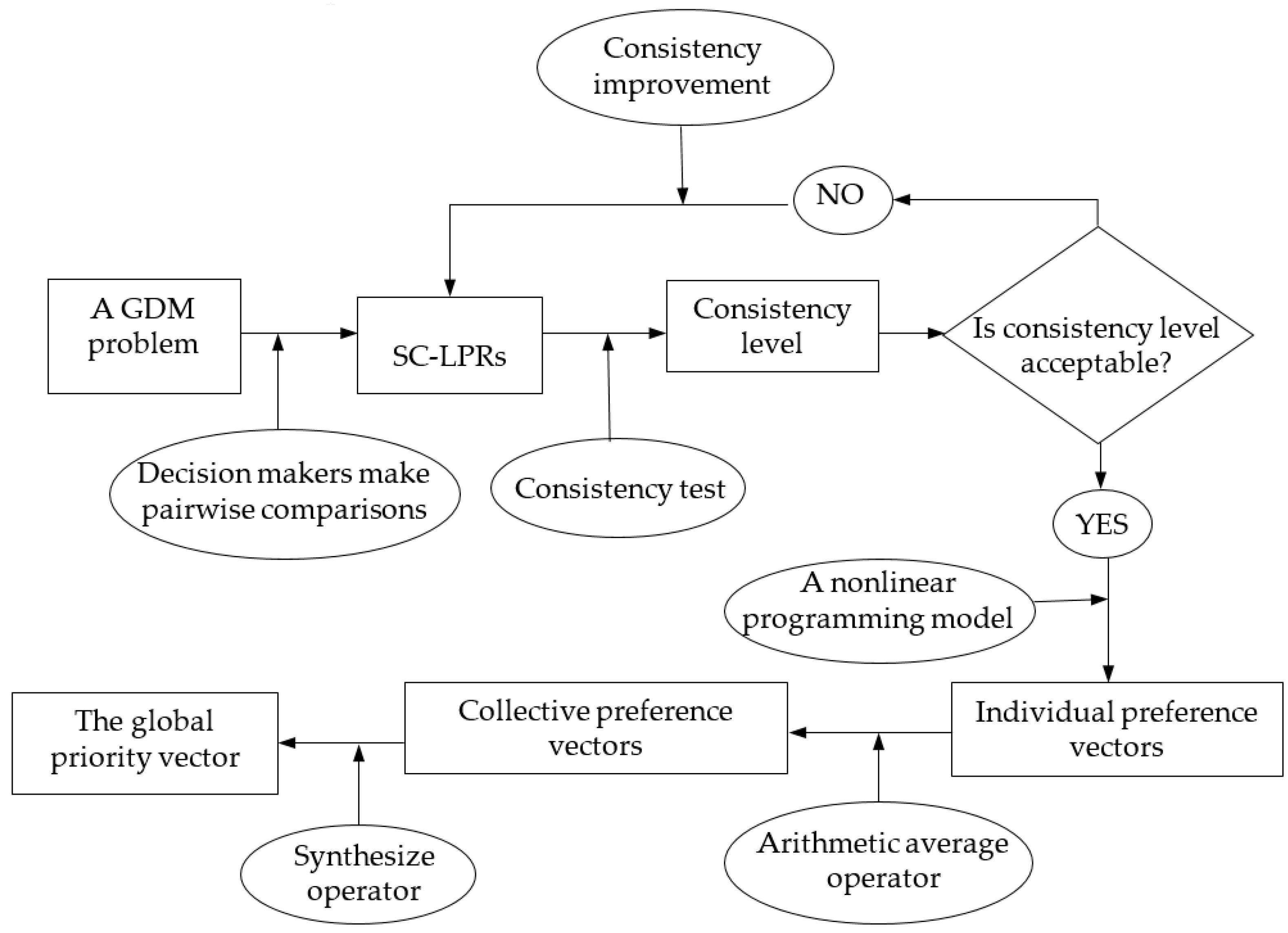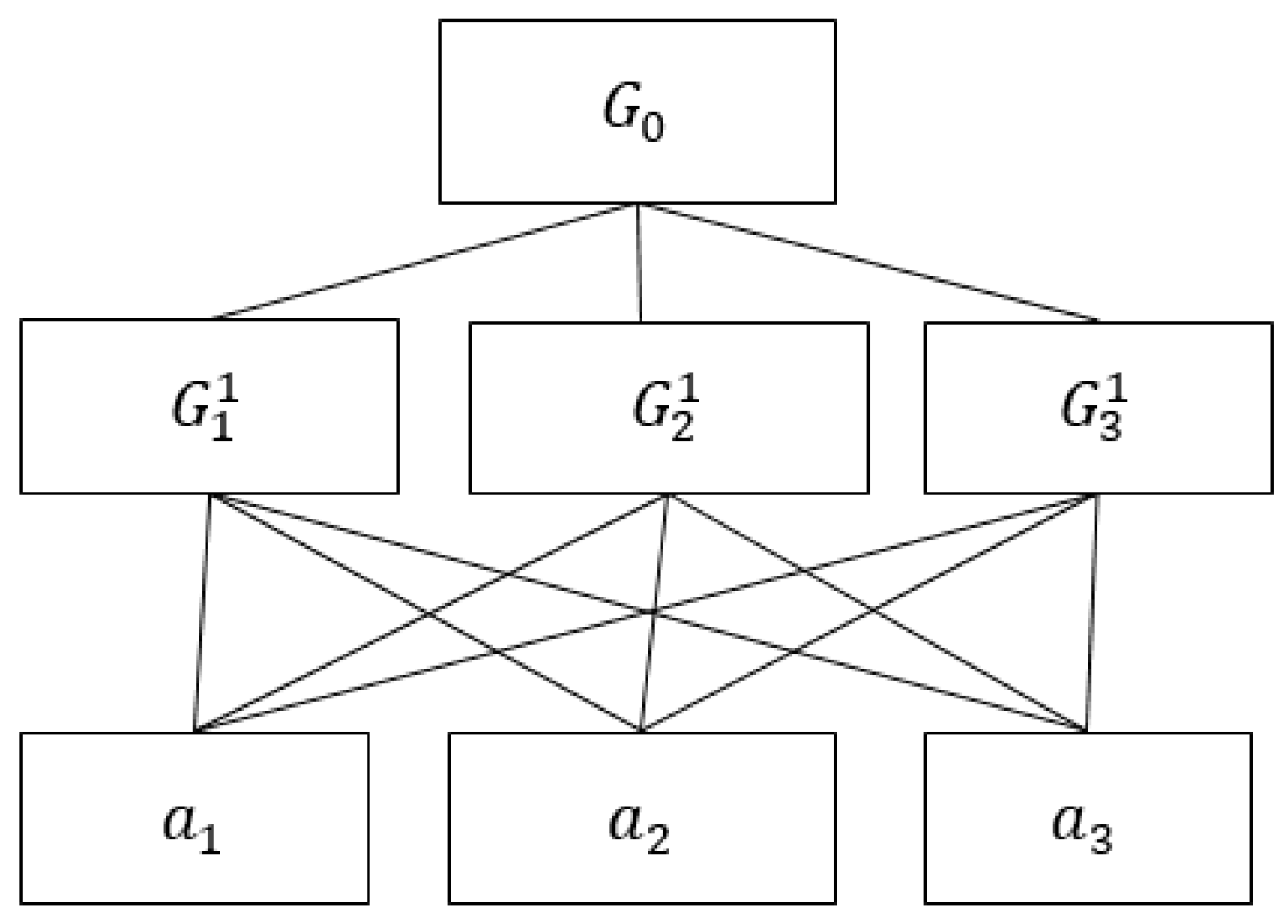A Linguistic Hierarchy Model with Self-Confidence Preference Relations and Its Application in Co-Regulation of Food Safety in China
Abstract
:1. Introduction
2. Literature Review
3. Preliminaries
3.1. The 2-Tuple Linguistic Model and Preference Relation
- (1)
- 2-tuples comparison operator: Let and be two 2-tuples, then:
- if , then is smaller than ;
- if , then
- (a)
- if , then and represents the same information;
- (b)
- if , then is smaller than ;
- (2)
- A 2-tuple negation operator:
3.2. Linguistic Preference Relations with Self-Confidence
3.3. Hierarchical Structure in Decision Making
4. Linguistic Hierarchy Model with Self-Confidence Preference Relations
4.1. Framework
4.2. Consistency Test Regarding SC-LPRs
4.3. Derive Individual Preference Vector from SC-LPRs
4.4. Detailed Decision Processes for Complex GDM
5. Case Study: Co-Regulation of Food Safety
5.1. Divide Co-Regulation of Food Safety into Hierarchy Sub-Problems
5.2. Application of LHM-SCPR to Co-Regulation of Food Safety
5.3. Comparative Analysis
6. Discussion: Contributions and Limitations
6.1. Contributions
6.2. Limitations
- (1)
- Consensus is one of important aspect within an interactive group [31,32,55,56,57,58,59], it has been widely analysed in some researches so as to guide decision makers to reach a consensus before making a decision, so that the obtained solution is acceptable for group. However, in this paper, we just only taken the consistency of SC-LPRs into consideration. It is one of the main limitations that we didn’t discussed consensus in the novel method.
- (2)
- Real-world GDM problems involve not only mathematical aspects but also psychological behaviors, such as self-confidence and personalized individual semantics [60]. Because different words mean different things to different people, we argue that it will be interesting to investigate the personalized individual semantics of decision makers in GDM problems.
7. Conclusions
- (1)
- We design a novel GDM framework, called LHM-SCPR, which connects hierarchical structure and self-confidence linguistic preference relations for complicated GDM problems.
- (2)
- We build a nonlinear programming model with minimum information deviation between decision makers’ preference relations and their individual preference vectors to gain individual preference vectors from SC-LPRs.
- (3)
- To illustrate the application value of the proposed LHM-SCPR, it is applied to analyse food safety governance in order to improve governance effectiveness.
Author Contributions
Acknowledgments
Conflicts of Interest
References
- Hochbaum, D.S.; Levin, A. Methodologies and algorithms for group-rankings decision. Manag. Sci. 2006, 52, 1394–1408. [Google Scholar] [CrossRef]
- Saaty, T.L. The Analytic Hierarchy Process; McGraw-Hill: New York, NY, USA, 1980. [Google Scholar]
- Abdel-Basset, M.; Gunasekaran, M.; Mohamed, M.; Chilamkurti, N. A framework for risk assessment, management and evaluation: Economic tool for quantifying risks in supply chain. Future Gener. Comput. Syst. Int. J. Sci. 2019, 90, 489–502. [Google Scholar] [CrossRef]
- Luthra, S.; Govindan, K.; Kannan, D.; Mangla, S.K.; Garg, C.P. An integrated framework for sustainable supplier selection and evaluation in supply chains. J. Clean. Prod. 2017, 140, 1686–1698. [Google Scholar] [CrossRef]
- Liu, W.Q.; Dong, Y.C.; Chiclana, F. Group decision-making based on heterogeneous preference relations with self-confidence. Fuzzy Optim. Decis. Mak. 2017, 16, 429–447. [Google Scholar] [CrossRef]
- Zhang, B.W.; Dong, Y.C.; Herrera-Viedma, E. Group decision making with heterogeneous preference structures: An automatic mechanism to support consensus reaching. Group Decis. Negot. 2019, 28, 585–617. [Google Scholar] [CrossRef]
- Wu, Y.Z.; Dong, Y.C.; Qin, J.D.; Witold, P. Flexible linguistic expressions and consensus reaching with accurate constraints in group decision making. IEEE Trans. Cybern. 2019, 1–14. [Google Scholar] [CrossRef]
- Wu, Y.Z.; Li, C.C.; Chen, X.; Dong, Y.C. Group decision making based on linguistic distributions and hesitant assessments: Maximizing the support degree with an accuracy constraint. Inf. Fusion 2018, 41, 151–160. [Google Scholar] [CrossRef]
- Orlovsky, S.A. Decision-making with a fuzzy preference relation. Fuzzy Sets Syst. 1978, 1, 155–167. [Google Scholar] [CrossRef]
- Dong, Y.C.; Li, C.C.; Xu, Y.; Gu, X. Consensus-Based Group Decision Making Under Multi-granular Unbalanced 2-Tuple Linguistic Preference Relations. Group Decis. Negot. 2015, 24, 217–242. [Google Scholar] [CrossRef]
- Dong, Y.C.; Liu, W.Q.; Chiclana, F.; Kou, G.; Herrera-Viedma, E. Are incomplete and self-confident preference relations better in multicriteria decision making? A simulation-based investigation. Inf. Sci. 2019, 492, 40–57. [Google Scholar] [CrossRef]
- Hu, K.; Liu, J.; Li, B.; Liu, L.L. Global research trends in food safety in agriculture and industry from 1991 to 2018: A data-driven analysis. Trends Food Sci. Technol. 2019, 85, 262–276. [Google Scholar] [CrossRef]
- Unnevehr, L.; Hoffmann, V. Food safety management and regulation: International experiences and lessons for China. J. Integr. Agric. 2015, 14, 2218–2230. [Google Scholar] [CrossRef]
- Zhang, M.; Qiao, H.; Wang, X.; Pu, M.Z.; Yu, Z.J.; Zheng, F.T. The third-party regulation on food safety in China: A review. J. Integr. Agric. 2015, 14, 2176–2188. [Google Scholar] [CrossRef]
- Chen, K.; Wang, X.X.; Song, H.Y. Food safety regulatory systems in Europe and China: A study of how co-regulation can improve regulatory effectiveness. J. Integr. Agric. 2015, 14, 2203–2217. [Google Scholar] [CrossRef]
- Liu, P.; Ma, L. Food scandals, media exposure, and citizens’ safety concerns: A multilevel analysis across Chines cities. Food Policy 2016, 63, 102–111. [Google Scholar] [CrossRef]
- Doumpos, M.; Zopounidis, C. Multicriteria Decision Aid Classification Methods; Springer Science: Berlin, Germany, 2002; Volume 73. [Google Scholar]
- Hwang, C.-L.; Yoon, K. Methods for Multiple Attribute Decision Making. Lect. Notes Econ. Math. Syst. 1981, 186, 58–191. [Google Scholar]
- Brans, J.P.; Mareschal, B. PROMETHEE V: MCDM problems with segmentation constraints. INFOR Inf. Syst. Oper. Res. 1992, 30, 85–96. [Google Scholar] [CrossRef]
- Roy, B.; Mousseau, V. A theoretical framework for analyzing the notion of relative importance of criteria. J. Multi-Criteria Decis. Anal. 1996, 5, 145–159. [Google Scholar] [CrossRef]
- Saaty, T.L. Decision Making with Dependence and Feedback: The Analytic Network Process; RWS Publications: Pittsburgh, PA, USA, 2001. [Google Scholar]
- Keršuliene, V.; Zavadskas, E.K.; Turskis, Z. Selection of rational dispute resolution method by applying new step-wise weight assessment ratio analysis (SWARA). J. Bus. Econ. Manag. 2010, 11, 243–258. [Google Scholar] [CrossRef]
- Gabus, A.; Fontela, E. World Problems, an Invitation to Further Thought within the Framework of DEMATEL; Battelle Geneva Research Center: Geneva, Switzerland, 1972; pp. 1–8. [Google Scholar]
- Churchman, C.W.; Ackoff, R.L. An approximate measure of value. J. Oper. Res. Soc. Am. 1954, 2, 172–187. [Google Scholar] [CrossRef]
- Zeleny, M. Multiple Criteria Decision Making; Mc Graw-Hill: New York, NY, USA, 1982. [Google Scholar]
- Micale, R.; La Fata, C.M.; La Scalia, G. A combined interval-valued ELECTRE TRI and TOPSIS approach for solving the storage location assignment problem. Comput. Ind. Eng. 2019, 135, 199–210. [Google Scholar] [CrossRef]
- Akgün, İ.; Erdal, H. Solving an Ammunition Distribution Network Design Problem Using Multi-Objective Mathematical Modeling, Combined AHP-TOPSIS, and GIS. Comput. Ind. Eng. 2019, 129, 512–528. [Google Scholar] [CrossRef]
- Supeekit, T.; Somboonwiwat, T.; Kritchanchai, D. DEMATEL-modified ANP to evaluate internal hospital supply chain performance. Comput. Ind. Eng. 2016, 102, 318–330. [Google Scholar] [CrossRef]
- Akman, G. Evaluating suppliers to include green supplier development programs via fuzzy c-means and VIKOR methods. Comput. Ind. Eng. 2015, 86, 69–82. [Google Scholar] [CrossRef]
- Sirisawat, P.; Kiatcharoenpol, T. Fuzzy AHP-TOPSIS approaches to prioritizing solutions for reverse logistics barriers. Comput. Ind. Eng. 2018, 117, 303–318. [Google Scholar] [CrossRef]
- Ramkumar, M.; Jenamani, M. E-procurement service provider selection—An analytic network process-based group decision-making approach. Serv. Sci. 2012, 4, 269–294. [Google Scholar] [CrossRef]
- Ramkumar, M.; Schoenherr, T.; Jenamani, M. Risk assessment of outsourcing e-procurement services: Integrating SWOT analysis with a modified ANP-based fuzzy inference system. Prod. Plan. Control 2016, 27, 1171–1190. [Google Scholar] [CrossRef]
- Ramkumar, M.; Jenamani, M. Sustainability in supply chain through e-procurement—An assessment framework based on DANP and liberatore score. IEEE Syst. J. 2014, 9, 1554–1564. [Google Scholar] [CrossRef]
- Ramkumar, M. A modified ANP and fuzzy inference system based approach for risk assessment of in-house and third party e-procurement systems. Strateg. Outsourcing Int. J. 2016, 9, 159–188. [Google Scholar] [CrossRef]
- Sharma, B.; Ramkumar, M.; Subramanian, N.; Malhotra, B. Dynamic temporary blood of facility location-allocation during and post-disaster periods. Ann. Oper. Res. 2017, 1–32. [Google Scholar] [CrossRef]
- Kim, S.; Ramkumar, M.; Subramaniam, N. Logistic service provider selection for disaster preparation: A socio-technical systems perspective. Ann. Oper. Res. 2018, 1–24. [Google Scholar] [CrossRef]
- Liu, Y.T.; Zhang, H.J.; Wu, Y.Z.; Dong, Y.C. Ranking range based approach to MADM under incomplete context and its application in venture investment evaluation. Technol. Econ. Dev. Econ. 2019, 1–23. (in press). [Google Scholar] [CrossRef]
- Zadeh, L.A. Fuzzy sets. Inf. Control 1965, 8, 338–353. [Google Scholar] [CrossRef] [Green Version]
- Buckley, J.J. Fuzzy hierarchical analysis. Fuzzy Sets Syst. 1985, 17, 233–247. [Google Scholar] [CrossRef]
- Jaiswal, R.K.; Ghosh, N.C.; Lohani, A.K.; Thomas, T. Fuzzy AHP Based Multi Criteria Decision Support for Watershed Prioritization. Water Resour. Manag. 2015, 29, 4205–4227. [Google Scholar] [CrossRef]
- Merigó, J.M.; Gil-Lafuente, A.M.; Yager, R.R. An overview of fuzzy research with bibliometric indicators. Appl. Soft Comput. 2015, 27, 420–433. [Google Scholar] [CrossRef]
- Herrera, F.; Martinez, L. A 2-tuple fuzzy linguistic representation model for computing with words. IEEE Trans. Fuzzy Syst. 2000, 8, 746–752. [Google Scholar] [Green Version]
- Dong, Y.C.; Zhang, G.Q.; Hong, W.C.; Yu, S. Linguistic computational model based on 2-tuples and intervals. IEEE Trans. Fuzzy Syst. 2013, 21, 1006–1018. [Google Scholar] [CrossRef]
- Herrera-Viedma, E.; Herrera, F.; Chiclana, F. A consensus model for multiperson decision making with different preference structures. IEEE Trans. Syst. Man Cybern. Part A Syst. Hum. 2002, 32, 394–402. [Google Scholar] [CrossRef]
- Dong, Y.C.; Herrera-Viedma, E. Consistency-driven automatic methodology to set interval numerical scales of 2-tuple linguistic GDM with preference relation. EEE Trans. Cybern. 2015, 45, 780–792. [Google Scholar] [CrossRef]
- Li, C.C.; Dong, Y.C.; Xu, Y.J.; Chiclana, F.; Herrera-Viedma, E.; Herrera, F. An overview on managing additive consistency of reciprocal preference relations for consistency-driven decision making and Fusion: Taxonomy and future directions. Inf. Fusion 2019, 52, 143–156. [Google Scholar] [CrossRef]
- Zhang, Z.; Guo, C.H. Consistency and consensus models for group decision-making with uncertain 2-tuple linguistic preference relations. Int. J. Syst. Sci. 2016, 47, 2572–2587. [Google Scholar] [CrossRef]
- Hu, H.; Li, X.; Nguyen, A.D.; Kavan, P. A critical evaluation of waste incineration plants in Wuhan based in site selection environmental influence, public healthy and public participation. Int. J. Environ. Res. Public Health 2015, 12, 7593–7614. [Google Scholar] [CrossRef] [PubMed]
- De Boeck, E.; Mortier, A.V.; Jacxsens, L.; Dequidt, L.; Vlerick, P. Towards an extended food safety culture model: Studying the moderating role of burnout and job-stress, the mediating role of food safety knowledge and motivation in the relation between food safety climate and food safety behavior. Trends Food Sci. Technol. 2017, 62, 202–214. [Google Scholar] [CrossRef]
- Guo, Z.D.; Bai, L.; Gong, S.L. Government regulations and voluntary certification in food safety in China: A review. Trends Food Sci. 2019, 90, 160–165. [Google Scholar] [CrossRef]
- Ergonul, B. Consumer awareness and perception to food safety: A consumer analysis. Food Control 2013, 32, 461–471. [Google Scholar] [CrossRef]
- Lim, T.P.; Chye, F.Y.; Sulaiman, M.R.; Suki, N.M.; Lee, J.S. A structural modeling on food safety knowledge, attitude, and behavior among Bum island community of Semporna, Sabah. Food Control 2016, 60, 241–246. [Google Scholar] [CrossRef]
- Mikhailov, L. A fuzzy programming method for deriving priorities in the analytic hierarchy process. J. Oper. Res. Soc. 1997, 51, 341–349. [Google Scholar] [CrossRef]
- Srdjevic, B. Combining different prioritization methods in the analytic hierarchy process synthesis. Comput. Oper. Res. 2005, 32, 1897–1919. [Google Scholar] [CrossRef]
- Zhang, H.J.; Dong, Y.C.; Palomares, I.; Zhou, H.W. Failure mode and effect analysis in a linguistic context: A consensus-based multi-attribute group decision-making approach. IEEE Trans. Reliab. 2019, 68, 566–582. [Google Scholar] [CrossRef]
- Zhang, H.J.; Dong, Y.C.; Chiclana, F.; Yu, S. Consensus efficiency in group decision making: A comprehensive comparative study and its optimal design. Eur. J. Oper. Res. 2019, 275, 580–598. [Google Scholar] [CrossRef]
- Gong, Z.W.; Xu, X.X.; Zhang, H.H.; Ozturk, U.A.; Herrera-Viedma, E.; Xu, C. The consensus models with interval preference opinions and their economic interpretation. Omega 2015, 55, 81–90. [Google Scholar] [CrossRef]
- Wu, Z.B.; Xu, J.P. Managing consistency and consensus in group decision making with hesitant fuzzy linguistic preference relations. Omega 2016, 65, 28–40. [Google Scholar] [CrossRef]
- Zhang, H.J.; Palomares, I.; Dong, Y.C.; Wang, W.W. Managing non-cooperative behaviors in consensus-based multiple attribute group decision making: An approach based on social network analysis. Knowl. Based Syst. 2018, 162, 29–45. [Google Scholar] [CrossRef]
- Xiao, J.; Wang, X.L.; Zhang, H.J. Managing personalized individual semantics and consensus in linguistic distribution large-scale group decision making. Inf. Fusion 2019, 53, 20–34. [Google Scholar] [CrossRef]
- De, M.P.; Ferrara, E.; Rosaci, D.; Sarne, G.M.L. Trust and compactness in social network group. IEEE Trans. Cybern. 2015, 45, 205–216. [Google Scholar]
- Ruiz-Villaverde, A.; Garcia-Rubio, M.A. Public participation in European water management: From theory to practice. Water Resour. Manag. 2017, 31, 2479–2495. [Google Scholar] [CrossRef]
- Liu, X.; Xu, Y.J.; Ge, Y.; Zhang, W.K.; Herrera, F. A group decision making approach considering self-confidence behaviors and its application in environment pollution emergency management. Int. J. Environ. Res. Public Health 2019, 16, 385. [Google Scholar] [CrossRef]
- Zhang, H.J.; Xiao, J.; Palomares, I.; Liang, H.M.; Dong, Y.C. Linguistic distribution-based optimization approach for large-scale GDM with comparative linguistic information. An application on the selection of wastewater disinfection technology. IEEE Trans. Fuzzy Syst. 2019, 1. [Google Scholar] [CrossRef]
- Li, C.C.; Dong, Y.C.; Herrera, F. A consensus model for large scale linguistic group decision making with a feedback recommendation based on clustered personalized individual semantics and opposing consensus groups. IEEE Trans. Fuzzy Syst. 2019, 27, 221–233. [Google Scholar] [CrossRef]
- Zhang, Z.; Guo, C.H.; Martinez, L. Managing multigranular linguistic distribution assessments in large-scale multiattribute group decision making. IEEE Trans. Syst. Man Cybern. Syst. 2017, 47, 3063–3076. [Google Scholar] [CrossRef]



| Year | Major Food Safety Accidents |
|---|---|
| 2005 | “Malachite Green Seafood”, “Leather Milk |
| 2006 | “Sudanese Red Duck Egg” |
| 2008 | “Melamine Milk Powder” |
| 2009 | “Leather Milk” |
| 2010 | “Waste Cooking Oil” |
| 2011 | “Leather Milk”, “Poisonous Pork with Clenbuterol” |
| 2013 | “Cadmium Rice”, “Poisonous Ginger” |
| 2015 | “Expired Frozen Meat” |
| 2016 | “Takeaway Hygiene” |
| 2018 | “Tongrentang Honey”, “Takeaway Hygiene” |
| Element | Semantics | |
|---|---|---|
| Goal | Public participate in co-regulation of food safety | |
| Criterion | Participation consciousness | |
| participation knowledge | ||
| Participation skills | ||
| Alternative | Popularize legal knowledge and strengthen the legal system | |
| Popularize food safety knowledge | ||
| Popularize methods and procedures of public affairs governance |
| SC-PRLs | Individual Preference Vector | |
|---|---|---|
| 0.247 | ||
| 0.123 | ||
| 0.416 | ||
| 0.243 | ||
| 0.246 | ||
| 0.480 | ||
| 1.302 | ||
| 0.265 | ||
| 0.224 | ||
| 0.569 | ||
| 1.138 | ||
| 1.000 |
| SC-PRLs | Individual Preference Vector | Collective Preference Vector | |
|---|---|---|---|
| 1.412 | |||
| 0.700 | |||
| 0.707 | |||
| 0.707 | |||
| 1.414 | |||
| 1.410 | |||
| 2.121 | |||
| 0.707 | |||
| 0.707 | |||
| 0.707 | |||
| 1.414 | |||
| 2.000 |
© 2019 by the authors. Licensee MDPI, Basel, Switzerland. This article is an open access article distributed under the terms and conditions of the Creative Commons Attribution (CC BY) license (http://creativecommons.org/licenses/by/4.0/).
Share and Cite
Fan, S.; Zhang, H.; Tang, H. A Linguistic Hierarchy Model with Self-Confidence Preference Relations and Its Application in Co-Regulation of Food Safety in China. Int. J. Environ. Res. Public Health 2019, 16, 2918. https://doi.org/10.3390/ijerph16162918
Fan S, Zhang H, Tang H. A Linguistic Hierarchy Model with Self-Confidence Preference Relations and Its Application in Co-Regulation of Food Safety in China. International Journal of Environmental Research and Public Health. 2019; 16(16):2918. https://doi.org/10.3390/ijerph16162918
Chicago/Turabian StyleFan, Sha, Hengjie Zhang, and Huali Tang. 2019. "A Linguistic Hierarchy Model with Self-Confidence Preference Relations and Its Application in Co-Regulation of Food Safety in China" International Journal of Environmental Research and Public Health 16, no. 16: 2918. https://doi.org/10.3390/ijerph16162918
APA StyleFan, S., Zhang, H., & Tang, H. (2019). A Linguistic Hierarchy Model with Self-Confidence Preference Relations and Its Application in Co-Regulation of Food Safety in China. International Journal of Environmental Research and Public Health, 16(16), 2918. https://doi.org/10.3390/ijerph16162918





